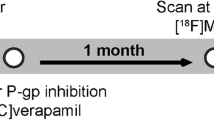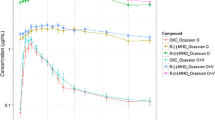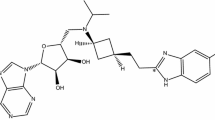Abstract
Purpose
(R)-[11C]verapamil is a new PET tracer for P-glycoprotein-mediated transport at the blood-brain barrier. For kinetic analysis of (R)-[11C]verapamil PET data the measurement of a metabolite-corrected arterial input function is required. The aim of this study was to assess peripheral (R)-[11C]verapamil metabolism in patients with temporal lobe epilepsy and compare these data with previously reported data from healthy volunteers.
Methods
Arterial blood samples were collected from eight patients undergoing (R)-[11C]verapamil PET and selected samples were analysed for radiolabelled metabolites of (R)-[11C]verapamil by using an assay that measures polar N-demethylation metabolites by solid-phase extraction and lipophilic N-dealkylation metabolites by HPLC.
Results
Peripheral metabolism of (R)-[11C]verapamil was significantly faster in patients compared to healthy volunteers (AUC of (R)-[11C]verapamil fraction in plasma: 29.4 ± 3.9 min for patients versus 40.8 ± 5.0 min for healthy volunteers; p < 0.0005, Student’s t-test), which resulted in lower (R)-[11C]verapamil plasma concentrations (AUC of (R)-[11C]verapamil concentration, normalised to injected dose per body weight: 25.5 ± 2.1 min for patients and 30.5 ± 5.9 min for healthy volunteers; p = 0.038). Faster metabolism appeared to be mainly due to increased N-demethylation as the polar [11C]metabolite fraction was up to two-fold greater in patients.
Conclusions
Faster metabolism of (R)-[11C]verapamil in epilepsy patients may be caused by hepatic cytochrome P450 enzyme induction by antiepileptic drugs. Based on these data caution is warranted when using an averaged arterial input function derived from healthy volunteers for the analysis of patient data. Moreover, our data illustrate how antiepileptic drugs may decrease serum levels of concomitant medication, which may eventually lead to a loss of therapeutic efficacy.



Similar content being viewed by others
References
McTavish D, Sorkin EM. Verapamil. An updated review of its pharmacodynamic and pharmacokinetic properties, and therapeutic use in hypertension. Drugs 1989;38(1):19–76.
Eichelbaum M, Ende M, Remberg G, Schomerus M, Dengler HJ. The metabolism of DL-[14C]verapamil in man. Drug Metab Dispos 1979;7(3):145–8.
Pauli-Magnus C, von Richter O, Burk O, Ziegler A, Mettang T, Eichelbaum M, et al. Characterization of the major metabolites of verapamil as substrates and inhibitors of P-glycoprotein. J Pharmacol Exp Ther 2000;293(2):376–82.
Ambudkar SV, Dey S, Hrycyna CA, Ramachandra M, Pastan I, Gottesman MM. Biochemical, cellular, and pharmacological aspects of the multidrug transporter. Annu Rev Pharmacol Toxicol 1999;39:361–98.
Hendrikse NH, Schinkel AH, de Vries EG, Fluks E, Van der Graaf WT, Willemsen AT, et al. Complete in vivo reversal of P-glycoprotein pump function in the blood-brain barrier visualized with positron emission tomography. Br J Pharmacol 1998;124(7):1413–8.
Syvänen S, Blomquist G, Sprycha M, Urban Hoglund A, Roman M, Eriksson O, et al. Duration and degree of cyclosporin induced P-glycoprotein inhibition in the rat blood-brain barrier can be studied with PET. Neuroimage 2006;32(3):1134–41.
Lee YJ, Maeda J, Kusuhara H, Okauchi T, Inaji M, Nagai Y, et al. In vivo evaluation of P-glycoprotein function at the blood-brain barrier in nonhuman primates using [11C]verapamil. J Pharmacol Exp Ther 2006;316(2):647–53.
Bart J, Willemsen AT, Groen HJ, van der Graaf WT, Wegman TD, Vaalburg W, et al. Quantitative assessment of P-glycoprotein function in the rat blood-brain barrier by distribution volume of [11C]verapamil measured with PET. Neuroimage 2003;20(3):1775–82.
Sasongko L, Link JM, Muzi M, Mankoff DA, Yang X, Collier AC, et al. Imaging P-glycoprotein transport activity at the human blood-brain barrier with positron emission tomography. Clin Pharmacol Ther 2005;77(6):503–14.
Kortekaas R, Leenders KL, van Oostrom JC, Vaalburg W, Bart J, Willemsen AT, et al. Blood-brain barrier dysfunction in parkinsonian midbrain in vivo. Ann Neurol 2005;57 2:176–9.
Brunner M, Langer O, Sunder-Plassmann R, Dobrozemsky G, Müller U, Wadsak W, et al. Influence of functional haplotypes in the drug transporter gene ABCB1 on central nervous system drug distribution in humans. Clin Pharmacol Ther 2005;78(2):182–90.
Toornvliet R, van Berckel BN, Luurtsema G, Lubberink M, Geldof AA, Bosch TM, et al. Effect of age on functional P-glycoprotein in the blood-brain barrier measured by use of (R)-[(11)C]verapamil and positron emission tomography. Clin Pharmacol Ther 2006;79(6):540–8.
Takano A, Kusuhara H, Suhara T, Ieiri I, Morimoto T, Lee YJ, et al. Evaluation of in vivo P-glycoprotein function at the blood-brain barrier among MDR1 gene polymorphisms by using 11C-verapamil. J Nucl Med 2006;47(9):1427–33.
Elsinga PH, Franssen EJ, Hendrikse NH, Fluks L, Weemaes AM, van der Graaf WT, et al. Carbon-11-labeled daunorubicin and verapamil for probing P-glycoprotein in tumors with PET. J Nucl Med 1996;37(9):1571–5.
Luurtsema G, Molthoff CF, Windhorst AD, Smit JW, Keizer H, Boellaard R, et al. (R)- and (S)-[11C]verapamil as PET-tracers for measuring P-glycoprotein function: in vitro and in vivo evaluation. Nucl Med Biol 2003;30(7):747–51.
Lubberink M, Luurtsema G, van Berckel BN, Boellaard R, Toornvliet R, Windhorst AD, et al. Evaluation of tracer kinetic models for quantification of P-glycoprotein function using (R)-[(11)C]verapamil and PET. J Cereb Blood Flow Metab 2007;27(2):424–33.
Franssen EJ, Luurtsema G, Lammertsma AA. Imaging P-glycoprotein at the human blood-brain barrier. Clin Pharmacol Ther 2006;80(3):302–303, author reply 303–4.
Luurtsema G, Molthoff CF, Schuit RC, Windhorst AD, Lammertsma AA, Franssen EJ. Evaluation of (R)-[11C]verapamil as PET tracer of P-glycoprotein function in the blood-brain barrier: kinetics and metabolism in the rat. Nucl Med Biol 2005;32(1):87–93.
Busse D, Cosme J, Beaune P, Kroemer HK, Eichelbaum M. Cytochromes of the P450 2C subfamily are the major enzymes involved in the O-demethylation of verapamil in humans. Naunyn Schmiedebergs Arch Pharmacol 1995;353(1):116–21.
Kroemer HK, Gautier JC, Beaune P, Henderson C, Wolf CR, Eichelbaum M. Identification of P450 enzymes involved in metabolism of verapamil in humans. Naunyn Schmiedebergs Arch Pharmacol 1993;348(3):332–7.
Thummel KE, Wilkinson GR. In vitro and in vivo drug interactions involving human CYP3A. Annu Rev Pharmacol Toxicol 1998;38:389–430.
Langer O, Bauer M, Hammers A, Karch R, Pataraia E, Koepp MJ, et al. Pharmacoresistance in epilepsy: a pilot PET study with the P-glycoprotein substrate R-[11C]verapamil. Epilepsia 2007;48(9):1774–84. DOI 10.1111/j.1528-1167.2007.01116.x.
Patsalos PN, Perucca E. Clinically important drug interactions in epilepsy: interactions between antiepileptic drugs and other drugs. Lancet Neurol 2003;2(8):473–81.
Patsalos PN, Perucca E. Clinically important drug interactions in epilepsy: general features and interactions between antiepileptic drugs. Lancet Neurol 2003;2(6):347–56.
Perucca E. Clinically relevant drug interactions with antiepileptic drugs. Br J Clin Pharmacol 2006;61(3):246–55.
Luurtsema G, Windhorst AD, Mooijer MPJ, Herscheid JDM, Lammertsma AA, Franssen EJF. Fully automated high yield synthesis of (R)- and (S)-[C-11]verapamil for measuring P-glycoprotein function with positron emission tomography. J Labelled Compd Rad 2002;45(14):1199–207.
Anderson GD. A mechanistic approach to antiepileptic drug interactions. Ann Pharmacother 1998;32(5):554–63.
Macphee GJ, McInnes GT, Thompson GG, Brodie MJ. Verapamil potentiates carbamazepine neurotoxicity: a clinically important inhibitory interaction. Lancet 1986;1(8483):700–3.
Hsiao P, Sasongko L, Link JM, Mankoff DA, Muzi M, Collier AC, et al. Verapamil P-glycoprotein transport across the rat blood-brain barrier: cyclosporine, a concentration inhibition analysis, and comparison with human data. J Pharmacol Exp Ther 2006;317(2):704–10.
Sisodiya SM, Bates SE. Treatment of drug resistance in epilepsy: one step at a time. Lancet Neurol 2006;5(5):380–1.
Löscher W. Drug transporters in the epileptic brain. Epilepsia 2007;48(suppl 1):8–13.
Summers MA, Moore JL, McAuley JW. Use of verapamil as a potential P-glycoprotein inhibitor in a patient with refractory epilepsy. Ann Pharmacother 2004;38(10):1631–4.
Iannetti P, Spalice A, Parisi P. Calcium-channel blocker verapamil administration in prolonged and refractory status epilepticus. Epilepsia 2005;46(6):967–9.
Barbarash RA, Bauman JL, Fischer JH, Kondos GT, Batenhorst RL. Near-total reduction in verapamil bioavailability by rifampin. Electrocardiographic correlates. Chest 1988;94(5):954–9.
Rutledge DR, Pieper JA, Mirvis DM. Effects of chronic phenobarbital on verapamil disposition in humans. J Pharmacol Exp Ther 1988;246(1):7–13.
Acknowledgements
This study could not have been completed without the excellent technical support of research nurse Edith Lackner from the Department of Clinical Pharmacology, and Rainer Bartosch and Ingrid Leitinger from the Department of Nuclear Medicine. The authors wish to thank Alexander Hammers and Matthias J. Koepp from the Department of Clinical and Experimental Epilepsy (University College London, UK) for discussion of results. The PET group from the Department of Nuclear Medicine (Medical University of Vienna) is gratefully acknowledged for continuous support. The metabolites of verapamil (D-617 and D-702) were a gift of Dr. Ute Hofmann from the Dr. Margarete Fisher-Bosch Institute (Stuttgart, Germany).
Author information
Authors and Affiliations
Corresponding author
Rights and permissions
About this article
Cite this article
Abrahim, A., Luurtsema, G., Bauer, M. et al. Peripheral metabolism of (R)-[11C]verapamil in epilepsy patients. Eur J Nucl Med Mol Imaging 35, 116–123 (2008). https://doi.org/10.1007/s00259-007-0556-5
Received:
Accepted:
Published:
Issue Date:
DOI: https://doi.org/10.1007/s00259-007-0556-5




